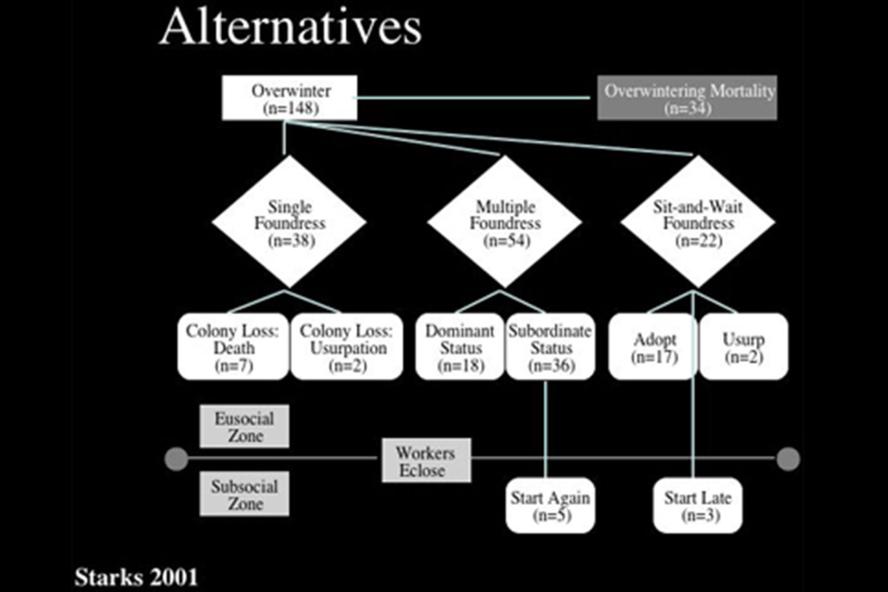Conflict, Cooperation, and Eusociality
The evolution of eusocial systems is considered one of the major transitions in the history of life on earth. Eusocial systems are characterized by a reproductive division of labor, an overlap of generations, and cooperative care of the young. Examining primitively eusocial animals may provide a glimpse at an intermediate stage between solitary and highly eusocial animals (Reeve & Keller 2001).
Since eusocial systems are defined by extreme reproductive skew (i.e. the degree to which one or a few animals monopolize the group's reproduction) it has been useful to examine how reproduction is shared between cooperative breeders (Keller & Reeve 1994, Nonacs 2001). Reproductive skew models, which include ecological and genetic information, accurately predict reproductive sharing in P. fuscatus wasps (Reeve et al. 2000). Research on P. dominulus (Queller et al. 2000; Liebert & Starks 2006), P. bellicosus (Field et al. 1998), and P. carolina (Sepp et al. 2002), however, failed to support reproductive skew models.
Reproductive skew models are often presented as providing a unified theory of social evolution (Reeve et al. 2000). It is not clear, however, if these models are even sufficient to describe cooperation within phylogenetically closely related paper wasps. What is clear, is that Polistes females engage in a number of alternative reproductive tactics (Reeve 1991; Reeve et al. 1998; Starks 1998, 2001).
Although the fitness payoffs of these alternatives are often hypothesized (see Reeve et al. 2000), actual values are necessary for fine-grade application of kin selection theory (Hamilton 1964). Due to difficulties with field populations (see Nonacs & Reeve 1993), these values have not been satisfactorily determined. My lab is working to remedy this problem using captive enclosure populations. This data will be used to generate a unified predictive model describing founding behavior in Polistes wasps.
Worker reproduction in honey bees and the policing necessary to reduce the selfish benefit is an example of conflict within a cooperative society (Ratnieks et al. 2001). Male-stuffing is another excellent example of this phenomenon: male-stuffing is an intracolonial behavioral mechanism that precludes males from consuming foraged items (Starks & Poe 1997). Watch the wasps approximately halfway between the center of the nest and its outer edge at '~4:00'.
My lab aims to determine if aggression directed at male nestmates is modulated by levels of relatedness, the per capita energy necessary to aggress the males, and/or the availability of resources. This form of conflict within a cooperative society is an instance where a multiple levels-of-selection approach is valuable in determining the behavior's selective advantage (see Wilson 2001). Thus this investigation will advance understanding of both conflict and cooperation within groups and the level of selection approach.




References
- Field J, Solis CR, Queller DC, & Strassmann JE. 1998: Social and genetic structure of paper wasp cofoundress associations: Tests of reproductive skew models. Am Nat 151: 545-563.
- Hamilton WD. 1964: The genetical evolution of social behaviour. I & II. Journal of Theoretical Biology 7: 1-52.
- Keller L & Reeve HK. 1994: Partitioning of reproduction in animal societies. Trends Ecol Evol, 9: 98-102.
- Liebert A, Starks PT (2006) Taming of the skew: transactional models fail to predict reproductive partitioning in the paper wasp Polistes dominulus. Animal Behaviour. 71, 913-923
- Nonacs P. 2001: A life-history approach to group living and social contracts between individuals. Annales Zoologici Fennici, 38: 239-254.
- Nonacs P & Reeve HK. 1993: Opportunistic adoption of orphaned nests in paper wasps as an alternative reproductive strategy. Behavioural Processes, 30, 47-60.
- Queller DC, Zacchi F, Cervo R, Turillazzi S, Henshaw MT, Santorelli LA, Strassmann JE (2000) Unrelated helpers in a social insect. Nature, 405, 784-787.
- Ratnieks FLW, Monnin T, Foster KR (2001) Inclusive fitness theory: novel predictions and tests in eusocial Hymenoptera. Annales Zoologici Finnici, 38: 201-214
- Reeve HK (1991) Polistes. In: The Social Biology of Wasps (ed. Matthews KRR), pp. pp. 99-148. Cornell University Press, Ithaca.
- Reeve HK & Keller L. 2001: Tests of reproductive-skew models in social insects. Annual Review of Entomology, 46: 347-385.
- Reeve HK, Peters JM, Nonacs P & Starks PT. 1998: Dispersal of first "workers" in social wasps: Causes and implications of an alternative reproductive strategy. Proc. Natl. Acad. Sci. USA, 95: 13737-13742.
- Reeve HK, Starks PT, Peters JM & Nonacs P. 2000: Genetic support for the evolutionary theory of reproductive transactions in social wasps. Proc. R. Soc. Lond. B, 267: 75-79.
- Seppä P, Queller DC & Strassmann JE. 2002: Reproduction in foundress associations of the social wasp, Polistes carolina: conventions, competition, and skew. Behavioral Ecology, 13: 531-542.
- Starks PT. 1998: A novel sit-and-wait reproductive strategy in social wasps. Proc. R. Soc. Lond. B, 265: 1407-1410.
- Starks PT. 2001: Alternative reproductive tactics in the paper wasp Polistes dominulus with specific focus on the sit-and-wait tactic. Annales Zoologici Finnici, 38: 198-199.
- Starks PT & Poe ES. 1997: 'Male-stuffing' in wasp societies. Nature, 389: 450-450
- Wilson DS. 2001: Evolutionary biology: Struggling to escape exclusively individual selection. Q Rev Biol, 76: 199-205.